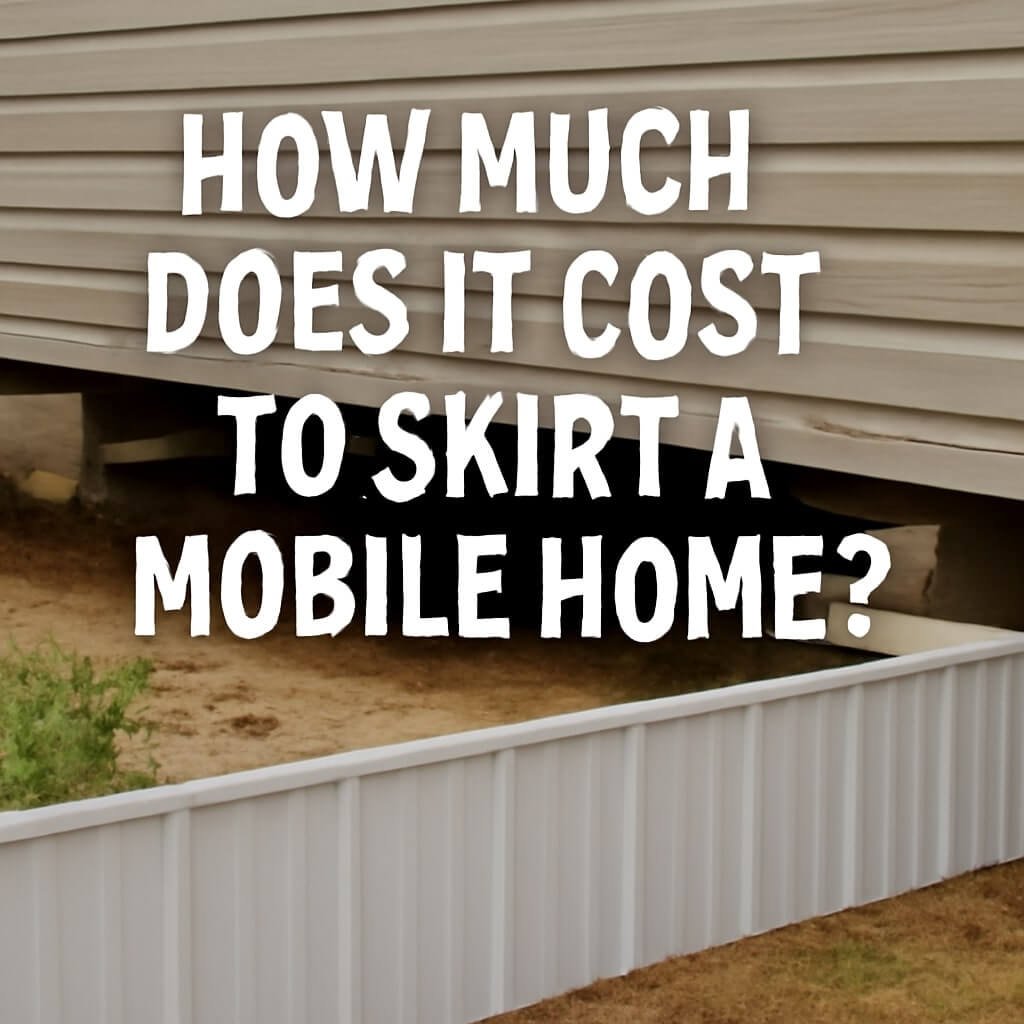Mobile home skirting refers to the material that encloses the area between the ground and the bottom of your mobile home. It’s essentially a protective barrier that wraps around the base, hiding unsightly foundations while providing essential benefits. Skirting can be made from various materials such as vinyl, metal, wood, or concrete, each offering unique advantages.
Skirting plays a critical role in maintaining the structural integrity and aesthetic appeal of your mobile home. Without it, you’re likely to encounter problems like pest infestation, heat loss, and even damage from weather elements.
Why Is Skirting Important for Mobile Homes?
You might be wondering, why bother with skirting at all? Here are some compelling reasons:
- Protection from Pests: Skirting acts as a barrier to keep rodents, insects, and other pests from nesting underneath your mobile home.
- Energy Efficiency: By insulating the crawl space beneath your home, skirting helps reduce heat loss in winter and heat gain in summer, saving you money on energy bills.
- Structural Support: It helps protect plumbing and wiring from damage caused by weather or animals.
- Improved Appearance: Skirting enhances curb appeal, making your home look finished and well-maintained.
- Prevents Debris Accumulation: Skirting keeps leaves, trash, and other debris from collecting under the home, which could cause damage over time.
In short, skirting is more than just a cosmetic upgrade; it’s an investment in the longevity and safety of your mobile home.
Factors Affecting the Cost of Skirting a Mobile Home
The cost to skirt a mobile home varies widely, depending on several factors:
- Material Type: The choice of material—vinyl, wood, metal, brick, or stone—heavily influences the cost.
- Size of the Home: Larger homes require more materials and labour.
- Labour Costs: Hiring professionals will cost more, but ensure a proper installation.
- Location: Regional labour rates and material availability can affect pricing.
- Permits and Inspections: Some areas require permits, adding to overall expenses.
- Design and Features: Decorative skirting or insulation adds to the price.
Understanding these factors helps you plan your budget more accurately.
Types of Materials Used for Mobile Home Skirting
Choosing the right material for your skirting is crucial for durability, cost-effectiveness, and aesthetics. Here’s a breakdown of common materials:
Vinyl Skirting
Vinyl is by far the most popular option due to its affordability and low maintenance. It’s resistant to moisture, insects, and rot. Vinyl skirting typically costs between $1.50 and $4.00 per square foot, depending on thickness and style.
Pros:
- Easy to install
- A variety of colours and patterns
- Weather resistant
Cons:
- Can crack in extreme cold
- Less durable than metal or wood
Metal Skirting
Metal skirting, often made from aluminum or steel, is highly durable and provides excellent protection. It tends to be pricier, generally around $3.00 to $7.00 per square foot.
Pros:
- Long-lasting and sturdy
- Resistant to pests and fire
Cons:
- Can dent or rust over time
- More expensive and harder to install
Wood Skirting
Wood gives a natural, warm look that many homeowners prefer. It can be painted or stained but requires regular maintenance to prevent rot and insect damage. Wood skirting costs roughly $2.50 to $6.00 per square foot.
Pros:
- Attractive and customizable
- Easy to paint or stain
Cons:
- Needs upkeep and weatherproofing
- Susceptible to pests and decay
DIY vs. Professional Installation: Which Is Better?
When considering skirting your mobile home, you’ll face a key decision: do it yourself or hire professionals.
DIY Installation:
- Cost Savings: DIY can save $500 to $1,500 in labor.
- Skill Required: Requires basic carpentry skills, tools, and time.
- Risks: Mistakes can lead to costly repairs or reduced lifespan of the skirting.
Professional Installation:
- Expertise: Ensures correct measurements and installation.
- Warranty: It often comes with a warranty on workmanship.
- Convenience: Saves time and hassle.
For those confident in their skills and with time on their hands, DIY is a cost-effective route. However, if you want a durable, professional look and peace of mind, hiring experts is recommended.
Step-by-Step Process to Skirt Your Mobile Home
Here’s a general overview of how mobile home skirting is installed:
- Measure Your Home: Get accurate measurements of the perimeter and height.
- Choose Materials: Decide on the best skirting material for your budget and style.
- Prepare the Site: Clear debris and level the ground around the foundation.
- Install Base: Attach a moisture barrier or base strip around the perimeter.
- Cut and Attach Panels: Fit skirting panels around the home, securing them firmly.
- Ventilation: Install vents to allow airflow under the home.
- Finish Edges: Seal corners and trim for a neat look.
Following these steps ensures your skirting lasts for years.
Average Costs for Different Sizes of Mobile Homes
Cost estimates for skirting vary by home size:
| Home Size | Estimated Cost Range |
|---|---|
| Small (up to 800 sq ft) | $800 – $1,500 |
| Medium (800 – 1,200 sq ft) | $1,200 – $2,500 |
| Large (1,200+ sq ft) | $2,500 – $5,000+ |
These ranges include material and labour costs. Keep in mind that higher-end materials and complex installations push costs higher.
Hidden Costs You Should Consider
Besides the obvious material and labour expenses, watch out for:
- Permits: Some municipalities require permits for skirting.
- Old Skirting Removal: Removing or disposing of old skirting can add fees.
- Repairs: Fixing underlying foundation or insulation issues.
- Seasonal Adjustments: Some materials may need weatherproofing treatments.
Budgeting for these ensures no surprises after you start.
How to Maintain Your Mobile Home Skirting
Proper maintenance prolongs the life of your skirting:
- Regular Cleaning: Wash vinyl or metal skirting to prevent dirt buildup.
- Inspect for Damage: Check for cracks, holes, or warping quarterly.
- Repair Promptly: Patch holes or replace damaged panels.
- Seasonal Care: Clear debris and check for moisture buildup annually.
Good upkeep keeps your home safe and attractive.
Common Mistakes to Avoid When Skirting Your Mobile Home
- Using incorrect measurements
- Choosing cheap materials that won’t last
- Ignoring local building codes and permits
- Skipping ventilation, which leads to moisture problems
- Neglecting maintenance after installation
Avoiding these pitfalls will save you money and frustration.
Financing Options for Skirting Your Mobile Home
If upfront costs seem high, consider:
- Home Improvement Loans: Personal loans designed for home upgrades.
- Payment Plans: Some contractors offer installment payments.
- Government Grants: Certain programs assist low-income homeowners.
- Credit Cards: Though with higher interest, useful for immediate financing.
Explore options to find what fits your budget best.
Frequently Asked Questions (FAQs)
How long does mobile home skirting last?
Depending on the material and maintenance, skirting can last 10 to 30 years.
Can I install skirting myself?
Yes, but it requires some DIY skills and the right tools.
Do I need a permit to skirt my mobile home?
This varies by location; check local building codes.
What is the best material for mobile home skirting?
Vinyl is popular for affordability, but metal offers greater durability.
How much does labour cost for professional skirting installation?
Labour typically ranges from $1 to $3 per square foot.
Will skirting improve my home’s energy efficiency?
Yes, it helps insulate the crawl space and reduce ener
Conclusion: Is Skirting Your Mobile Home Worth the Investment?
Skirting your mobile home offers multiple benefits—protecting your investment, enhancing curb appeal, improving energy efficiency, and preventing costly damage. While the cost varies based on materials, size, and installation method, the advantages outweigh the expense. Whether you DIY or hire professionals, properly installed and maintained skirting is a smart long-term investment.













